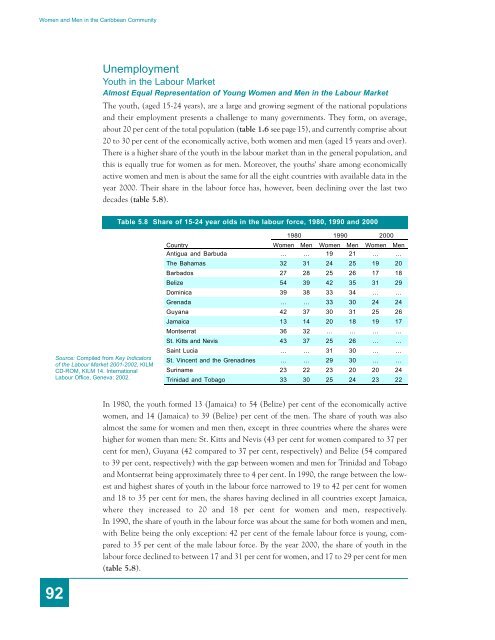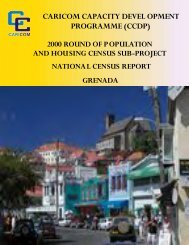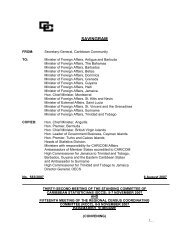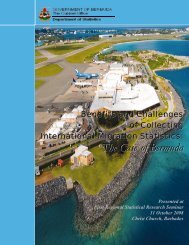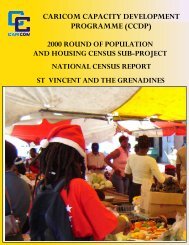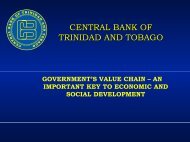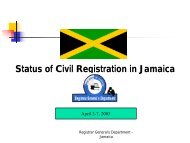Women and Men in the Caribbean Community
Facts and Figures, 1980-2001 - CARICOM Statistics
Facts and Figures, 1980-2001 - CARICOM Statistics
Create successful ePaper yourself
Turn your PDF publications into a flip-book with our unique Google optimized e-Paper software.
<strong>Women</strong> <strong>and</strong> <strong>Men</strong> <strong>in</strong> <strong>the</strong> <strong>Caribbean</strong> <strong>Community</strong>UnemploymentYouth <strong>in</strong> <strong>the</strong> Labour MarketAlmost Equal Representation of Young <strong>Women</strong> <strong>and</strong> <strong>Men</strong> <strong>in</strong> <strong>the</strong> Labour MarketThe youth, (aged 15-24 years), are a large <strong>and</strong> grow<strong>in</strong>g segment of <strong>the</strong> national populations<strong>and</strong> <strong>the</strong>ir employment presents a challenge to many governments. They form, on average,about 20 per cent of <strong>the</strong> total population (table 1.6 see page 15), <strong>and</strong> currently comprise about20 to 30 per cent of <strong>the</strong> economically active, both women <strong>and</strong> men (aged 15 years <strong>and</strong> over).There is a higher share of <strong>the</strong> youth <strong>in</strong> <strong>the</strong> labour market than <strong>in</strong> <strong>the</strong> general population, <strong>and</strong>this is equally true for women as for men. Moreover, <strong>the</strong> youths' share among economicallyactive women <strong>and</strong> men is about <strong>the</strong> same for all <strong>the</strong> eight countries with available data <strong>in</strong> <strong>the</strong>year 2000. Their share <strong>in</strong> <strong>the</strong> labour force has, however, been decl<strong>in</strong><strong>in</strong>g over <strong>the</strong> last twodecades (table 5.8).Table 5.8 Share of 15-24 year olds <strong>in</strong> <strong>the</strong> labour force, 1980, 1990 <strong>and</strong> 2000Source: Compiled from Key Indicatorsof <strong>the</strong> Labour Market 2001-2002, KILMCD-ROM, KILM 14. InternationalLabour Office, Geneva: 2002.1980 1990 2000Country <strong>Women</strong> <strong>Men</strong> <strong>Women</strong> <strong>Men</strong> <strong>Women</strong> <strong>Men</strong>Antigua <strong>and</strong> Barbuda … … 19 21 … …The Bahamas 32 31 24 25 19 20Barbados 27 28 25 26 17 18Belize 54 39 42 35 31 29Dom<strong>in</strong>ica 39 38 33 34 … …Grenada … … 33 30 24 24Guyana 42 37 30 31 25 26Jamaica 13 14 20 18 19 17Montserrat 36 32 … … … …St. Kitts <strong>and</strong> Nevis 43 37 25 26 … …Sa<strong>in</strong>t Lucia … … 31 30 … …St. V<strong>in</strong>cent <strong>and</strong> <strong>the</strong> Grenad<strong>in</strong>es … … 29 30 … …Sur<strong>in</strong>ame 23 22 23 20 20 24Tr<strong>in</strong>idad <strong>and</strong> Tobago 33 30 25 24 23 22In 1980, <strong>the</strong> youth formed 13 (Jamaica) to 54 (Belize) per cent of <strong>the</strong> economically activewomen, <strong>and</strong> 14 (Jamaica) to 39 (Belize) per cent of <strong>the</strong> men. The share of youth was alsoalmost <strong>the</strong> same for women <strong>and</strong> men <strong>the</strong>n, except <strong>in</strong> three countries where <strong>the</strong> shares werehigher for women than men: St. Kitts <strong>and</strong> Nevis (43 per cent for women compared to 37 percent for men), Guyana (42 compared to 37 per cent, respectively) <strong>and</strong> Belize (54 comparedto 39 per cent, respectively) with <strong>the</strong> gap between women <strong>and</strong> men for Tr<strong>in</strong>idad <strong>and</strong> Tobago<strong>and</strong> Montserrat be<strong>in</strong>g approximately three to 4 per cent. In 1990, <strong>the</strong> range between <strong>the</strong> lowest<strong>and</strong> highest shares of youth <strong>in</strong> <strong>the</strong> labour force narrowed to 19 to 42 per cent for women<strong>and</strong> 18 to 35 per cent for men, <strong>the</strong> shares hav<strong>in</strong>g decl<strong>in</strong>ed <strong>in</strong> all countries except Jamaica,where <strong>the</strong>y <strong>in</strong>creased to 20 <strong>and</strong> 18 per cent for women <strong>and</strong> men, respectively.In 1990, <strong>the</strong> share of youth <strong>in</strong> <strong>the</strong> labour force was about <strong>the</strong> same for both women <strong>and</strong> men,with Belize be<strong>in</strong>g <strong>the</strong> only exception: 42 per cent of <strong>the</strong> female labour force is young, comparedto 35 per cent of <strong>the</strong> male labour force. By <strong>the</strong> year 2000, <strong>the</strong> share of youth <strong>in</strong> <strong>the</strong>labour force decl<strong>in</strong>ed to between 17 <strong>and</strong> 31 per cent for women, <strong>and</strong> 17 to 29 per cent for men(table 5.8).92


